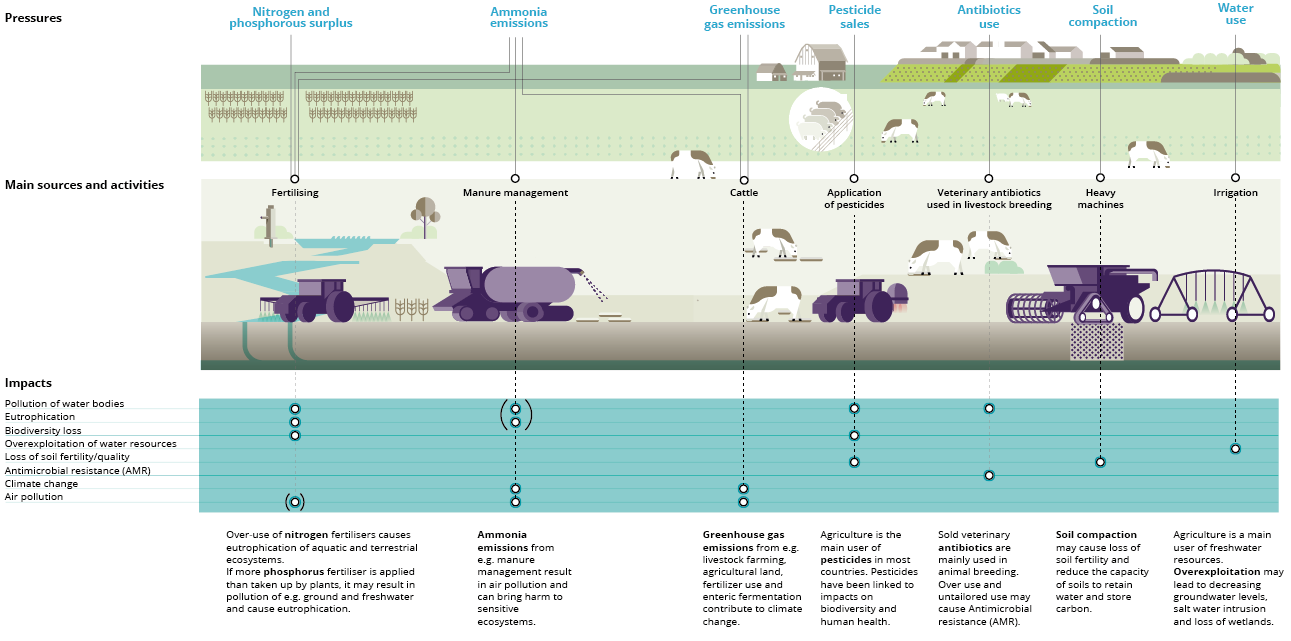The ground below our feet is much more than rocks, soil and silt. Every square metre can be unique in terms of its composition, its structure and the life that it contains and supports. Some contain more rocks rich in certain minerals; others are rich in plant residues with pockets of air and water.
Soil is often a neglected domain of biodiversity but even a small patch can teem with life, ranging from tiny organisms to fungi and earthworms, all playing a vital role in the functioning of the soil ecosystem. It is also in this space that nutrients are turned into forms that plants can take up, allowing biomass to form and store carbon. It is also here that our prospective drinking water starts its natural purification journey towards groundwater.
A local problem?
The way we use land often introduces additional substances to these unique ecosystems in order to protect selected crops or add nutrients. Pollutants released from industry, transport and other economic activities can also travel long distances and reach soils, where they become diluted and are temporarily stored. Soil, a component of land, is considered polluted when contaminants adversely affect human health or the environment.
With every step we take, we could be standing on top of a very different mix and concentration of contaminants in the ground. The large variation of contaminants, soils, and climatic and land use conditions makes it costly to monitor and assess the full extent of land and soil pollution. What we know is mostly based on field samples scattered across countries.
Heavy metals, fertilisers and pesticides
We need agriculture to grow our food but some unsustainable farming practices continue to contaminate soils.
Plants need, among other things, nutrients to grow and intensive agriculture can deplete nutrients in the soil faster than nature replenishes them. Fertilisers work by compensating this deficit by introducing extra nutrients. Unfortunately, the whole amount is often not taken up by the plants and the surplus that is initially in soil, sooner or later, enters lakes and rivers. Once in water, surplus nitrogen often leads to excessive growth of plants and algae, the decomposition of which can severely reduce oxygen levels in water, harming animal and plant species in that ecosystem.
Copper has been used extensively as a fungicide in vineyards and orchards for decades. A recent large-scale study showed that copper concentrations in vineyards were three times higher than the average in European soils. Copper is also added to animal feed and is introduced to the environment when manure is spread over grasslands and other agricultural lands.
Cadmium is another highly toxic metal found in mineral phosphorus fertilisers. Some ‘organic fertilisers’, such as sewage sludges, manure, compost and bio-waste, can also introduce a broad mix of heavy metals and organic pollutants if they are not well regulated.
Chemicals from the long-term use of pesticides are also found in soil samples from across Europe. Over 80 % of soils tested in one study contained pesticide residues, with 58 % containing two or more types of residue.
Waste management, industry and beyond the borders
Agricultural practices are far from being the only source of land and soil pollution. Poorly managed waste — both municipal and industrial waste — is responsible for more than one third of local contaminations, followed by industrial activities. Of the several millions of sites estimated to carry out potentially polluting activities in the EU, detailed public information exists for only a fraction.
Land and soil pollution is also a global problem. Air and water can transport pollutants, including nitrogen compounds and tiny plastic fragments, across the globe and deposit them on land surfaces. Pollutants are found even on the highest peaks and the most remote beaches.
Forever they remain and accumulate
Some pollutants break down in soil over time but others remain forever. In many cases, land and its soils are the final destination where various pollutants end up and accumulate over time. The full risks of these chemicals and various mixes of them are not fully known. However, based on sampled sites, we know that land and soil pollution can have significant impacts on human health as well as soil biodiversity and ecosystem health. These pollutants can affect soil organisms and possibly contaminate our food and drinking water.
Remediating contaminated land is difficult and expensive, but necessary to clean up past pollution. However, local authorities often lack the means and tools to manage remediation. More than 65 000 sites have been remediated in the EU; however, by far, most potentially contaminated sites are still left untouched.
Best solution — prevention
Prevention remains the most effective and cheapest way to ensure healthy soils — and cleaner water and air — in the long term. Any initiative aimed at preventing and reducing pollution — from product design, better recycling, waste management, crop rotation, precision farming and reduced pesticide and fertiliser use to cleaner transport and industry — and at supporting authorities to implement effective measures will contribute to alleviating pressures on these vital ecosystems.
Many existing and upcoming policy initiatives under the European Green Deal — the circular economy, the farm to fork strategy, the biodiversity strategy, the chemicals strategy, the new soil strategy and the zero pollution action plan — provide a European framework and support national authorities and land users to protect land and soils from pollution. Additional support to local authorities and a more coherent EU policy framework on soil would further reinforce these efforts. After all, pollution is only one of the many threats that soils and land face.
Pollution and other impacts of agriculture on the environment
Agriculture has multiple impacts on the environment, climate and human health. Unsustainable farming practices lead to pollution of soil, water, air and food and over-exploitation of natural resources.
Source: EEA report - The European environment — state and outlook 2020; EEA infographic.

Document Actions
Share with others